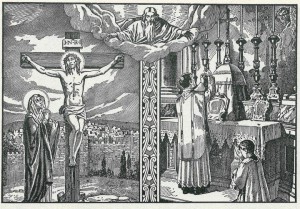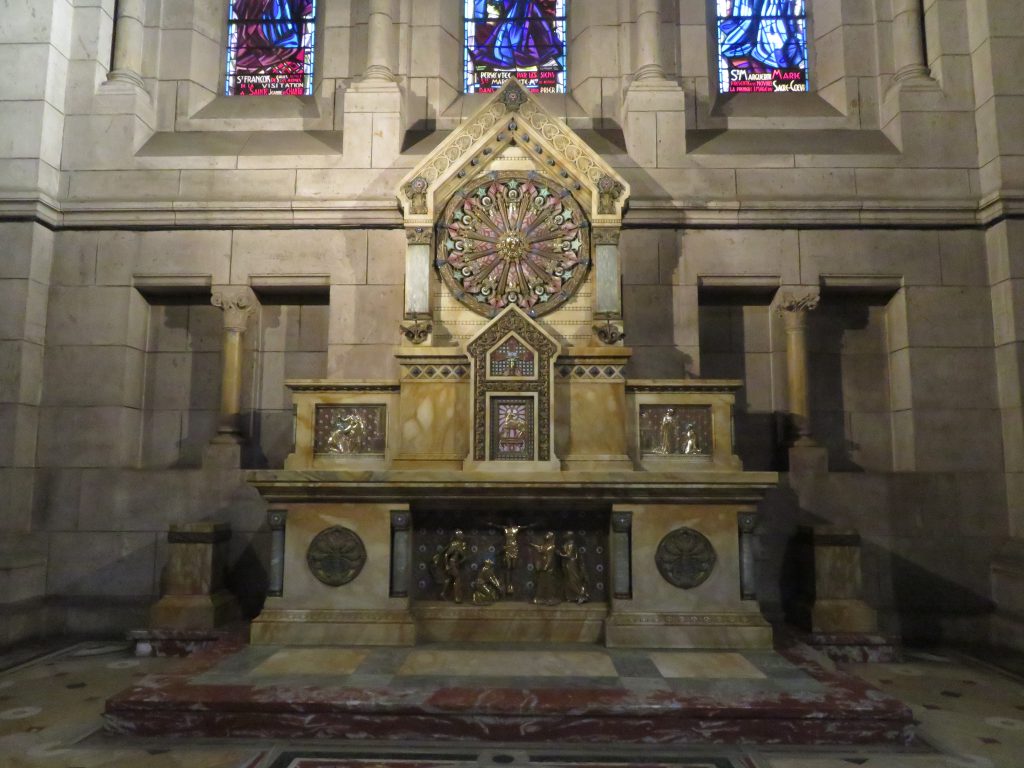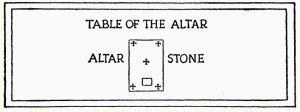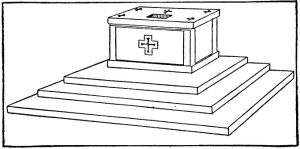 The other day at lunch with a friend who was driving through the zone, after hearing a few of the things he had lately encountered in the Church I opined that we are moving from our phase of naive ecclesiastical Dadaism – naive because it embraces the modernism which ought to be mocked and shunned – into full blown Theater of the Absurd, sure to be inaugurated with a performance of La Cantatrice Chauve at the Pan-Amazonian Synod.
The other day at lunch with a friend who was driving through the zone, after hearing a few of the things he had lately encountered in the Church I opined that we are moving from our phase of naive ecclesiastical Dadaism – naive because it embraces the modernism which ought to be mocked and shunned – into full blown Theater of the Absurd, sure to be inaugurated with a performance of La Cantatrice Chauve at the Pan-Amazonian Synod.
And then there comes this.
From a reader…
QUAERITUR:
Our parish’s altar was damaged when we had ceiling issues and the priest has been asking us to contribute stones to make a design in the new altar table. I thought altars were supposed to be plain, not have designs of a river, made with local pebbles, on the top? Per the bulletin, “We are working on refurbishing our Altar Table from XX. We are using an old base altar from the Church. The new table top is being fashioned from our church’s original foundation beams. Through it, an image of the rivers that run through our parish is being artistically created. We need small stones, pebbles, and rocks from you…from the (Creek names) to place within our “River of Life” in the Lord’s Table. The new Table will be from and of us…from and of our Creator. Please bring your stones to our office. Remember the old altar table top was damaged by the falling ceiling.”
“Please bring your stones to our office.”
If only our bishops would heed that admonition.
Gee, I dunno. This smacks of sentimentality. It’s “nice” to include everyone. I suspect that there may be quite the cadres of EMHCs there, too. But now I am speculating, perhaps unfairly.
The blurb can be read benignly: the table – from us and from our Creator. Christ was “from us and from our Creator” in that He, the Creator, took the humanity He created into an indestructible bond with His divinity. The sacraments are sometimes depicted as a river flowing from Christ’s Body on the Cross. So, without seeing the design, it’s hard to proceed. But I am suspicious.
You write, “I thought altars were supposed to be plain, not have designs of a river, made with local pebbles, on the top?”
It’s the “on the top” that bugs me. The design “on the top”? On the top or on the side of the top? Forgive me for being cynical. By now we’ve all seen a great deal of nonsense.
The mensae of altars – indeed the whole altar – ought to reflect Christ’s wounded Body suffering on the Cross for our redemption and remaining gloriously wounded in His, and our, Resurrection.
Instead, you might get “a river runs through it” or the Dry Salvages. I can picture all sorts of nonsense.
Meanwhile, as far as “plain” is concerned, not so much. While the top slab of the altar should be plain, indeed, austere, the rest of the altar complex can be, and indeed sometimes ought to be decorous to magnificent, according to the means of the people. For example, here is a sadly unused but glorious altar in one of the side chapels of Sacré-Cœur in Paris which I snapped last November.

I assure you that the table top, the mensa, is plain but for the proper incised crosses and place for relics.
Going back to the ancient Church we have understood that there is an intimate connection between the altar and the Person of Christ.
This is founded on the fact that Christian sacrifice is wholly different from any other kind of sacrifice of other religions before or after. Whereas sacrifice was always a work of man offered to gods, Christian sacrifice is God’s own work for our sake. Christ Himself is simultaneously the priest offering the Sacrifice, the Sacrifice being offered and the very place of the offering, the altar.
Christ and the altar are identified with each other. The altar is Christ.
This is why the surface of the altar traditionally is incised with crosses, marking the wounds in His Body. Even when an altar hasn’t been constructed entirely of stone, there is nevertheless an altar stone placed into the mensa, table top, with the “sepulcher” for the relics to be placed within.

Wooden altars were never the norm or ideal, though they were common enough, especially in churches that were not yet entirely paid for and, hence, could be used but not consecrated. After years of use, habit settled in and those wooden altars were not upgraded and the whole place solemnly consecrated. Many country churches are like this: wooden table tops with inset altar stones, rather than the table tops made entirely of stone.
And when the altar is completely constructed, and not temporary, the whole mensa receives the inscription of the wounds.

The Catechism of the Catholic Church states: “1383. … the Christian altar is the symbol of Christ himself, present in the midst of the assembly of his faithful, both as the victim offered for our reconciliation and as food from heaven who is giving himself to us. ‘For what is the altar of Christ if not the image of the Body of Christ?’ asks St. Ambrose. He says elsewhere, ‘The altar represents the body [of Christ] and the Body of Christ is on the altar’”.
Anything that has to do with the altar, should reflect this mystery.
Indeed, what happens here? The most amazing action that any human can be permitted in this life to participate in, pace a certain Jesuit’s omphaloskepsis, transubstantiation. The priest speaks and Christ comes.
The traditional rites of the consecration of an altar are truly awesome, for they reflect centuries of our forebears reflection on the meaning of everything that happens on and around this sacrosanct locus of encounter with God. We have, therefore, given beautiful settings to our altars, just as we make beautiful frames for paintings or rings for gems. The altar mensa itself remains austere from our respect.
We cloth the altar in Christ’s winding shrouds, the altar cloths. We adorn its setting, its frame, with vestments which reflect its dignity. This is why we use the antependium, often matching the vestments of the day. This is why we built our altars with “steps” or gradines, on the liturgically Eastern edge: we should not put things on the surface which are not used for the Sacrifice. Flowers and other ornaments, even the candlesticks, go on the gradines, not the mensa. Only the book and vessels with linens for Mass rest on the mensa, and perhaps a signaling Sanctus candle.
Our music, our vestments, our vessels, our buildings, our altars, our paintings, frescos and pavements all simultaneously reflect who their makers believe the Church to be, our ecclesiology, and they also shape our ecclesiology. Contrast Sacré-Cœur in Paris with the municipal airport terminals people are building now. Contrast, say, the Shrine of Our Lady of Guadalupe in La Crosse, WI, with the disorienting carpeted Imax monstrosities that torment the souls of Catholics who believe in the Real Presence after, let’s say it again just to make a point, transubstantiation.
Walk into a church and take a good look. You can tell a lot by what is there, and what isn’t, by the choices made and rejected, by the proportions, style and lines of sight.
Hence, the importance of the altar, a sacrament of Christ within the holy of holies within the sacred space.
































I recall a priest showing the parishes their new Altar, with an emphasis on showing the relics. The Altar was wood, similar to a table. There was no Altar Stone on top, and no adornments (the carved cross in your illustration) the relics were a collection of medallions, or relic rosaries in a drawer under the table top. Valid or not? I do not know.
I’ve seen some pretty horrendous looking altars in some (mostly 1960s+) churches in my diocese. I’m having a hard time picturing what they are describing but “river of life in the Lord’s table” made me throw up in my mouth a little.
On a side note, rather than pebbles and small stones, our Church needs more millstones. There seems to be a shortage, as that Pew research would indicate.
Ecclesiastical Dadaism. That is far more accurate than what I have been terming Bergoglian abstract expressionism. It makes far more sense.
I am imagining the altar to be made of a clear resin with these collected river stones embedded. Essentially, I imagine the altar mensa would like the bottom of creek…very pretty for a bathroom countertop…not for an altar.
I fear that what they envision is a “river table”, where an irregular strip of clear epoxy is sandwiched between two planks of wood.
It’s a current design trend, but it will pass, leaving an altar as dated as the felt banners and god’s eyes of the 1970’s. Few things demonstrate the triumph of transience over the transcendent better/worse than dated art.
Parishioners brought bricks to build Old St. Mary’s of Cincinnati in 1841… and baked them in the ovens of their own homes.
The altar is Christ, not an art project.
Where is the pastor getting his inspiration, the Dickeyville Grotto?
Thank you for this very informative post. I learned quite a lot from it, and was reminded I need to review The Catechism again.